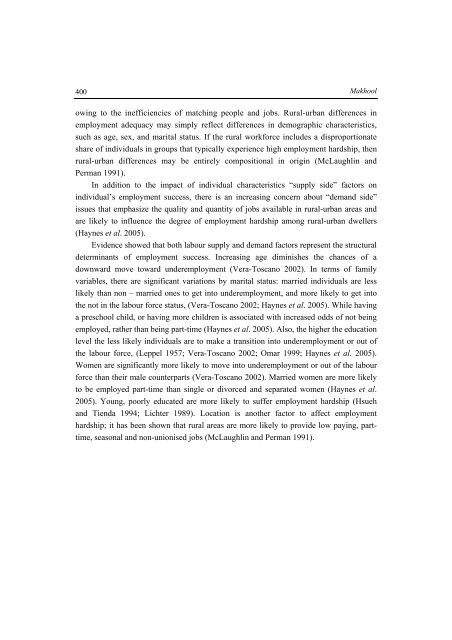The Palestinian Economy. Theoretical and Practical Challenges
The Palestinian Economy. Theoretical and Practical Challenges
The Palestinian Economy. Theoretical and Practical Challenges
You also want an ePaper? Increase the reach of your titles
YUMPU automatically turns print PDFs into web optimized ePapers that Google loves.
400<br />
Makhool<br />
owing to the inefficiencies of matching people <strong>and</strong> jobs. Rural-urban differences in<br />
employment adequacy may simply reflect differences in demographic characteristics,<br />
such as age, sex, <strong>and</strong> marital status. If the rural workforce includes a disproportionate<br />
share of individuals in groups that typically experience high employment hardship, then<br />
rural-urban differences may be entirely compositional in origin (McLaughlin <strong>and</strong><br />
Perman 1991).<br />
In addition to the impact of individual characteristics “supply side” factors on<br />
individual’s employment success, there is an increasing concern about “dem<strong>and</strong> side”<br />
issues that emphasize the quality <strong>and</strong> quantity of jobs available in rural-urban areas <strong>and</strong><br />
are likely to influence the degree of employment hardship among rural-urban dwellers<br />
(Haynes et al. 2005).<br />
Evidence showed that both labour supply <strong>and</strong> dem<strong>and</strong> factors represent the structural<br />
determinants of employment success. Increasing age diminishes the chances of a<br />
downward move toward underemployment (Vera-Toscano 2002). In terms of family<br />
variables, there are significant variations by marital status: married individuals are less<br />
likely than non – married ones to get into underemployment, <strong>and</strong> more likely to get into<br />
the not in the labour force status, (Vera-Toscano 2002; Haynes et al. 2005). While having<br />
a preschool child, or having more children is associated with increased odds of not being<br />
employed, rather than being part-time (Haynes et al. 2005). Also, the higher the education<br />
level the less likely individuals are to make a transition into underemployment or out of<br />
the labour force, (Leppel 1957; Vera-Toscano 2002; Omar 1999; Haynes et al. 2005).<br />
Women are significantly more likely to move into underemployment or out of the labour<br />
force than their male counterparts (Vera-Toscano 2002). Married women are more likely<br />
to be employed part-time than single or divorced <strong>and</strong> separated women (Haynes et al.<br />
2005). Young, poorly educated are more likely to suffer employment hardship (Hsueh<br />
<strong>and</strong> Tienda 1994; Lichter 1989). Location is another factor to affect employment<br />
hardship; it has been shown that rural areas are more likely to provide low paying, parttime,<br />
seasonal <strong>and</strong> non-unionised jobs (McLaughlin <strong>and</strong> Perman 1991).
















